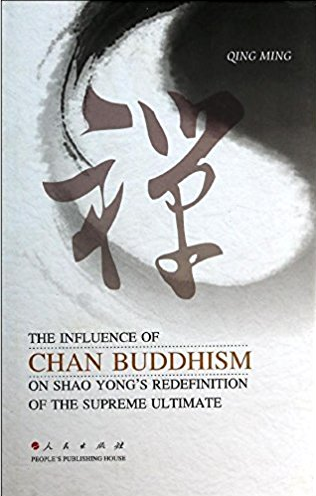
5分
禅宗对邵雍重新定义太极思想的影响

温馨提示:5折以下图书主要为出版社尾货,大部分为全新(有塑封/无塑封),个别图书品相8-9成新、切口有划线标记、光盘等附件不全详细品相说明>>
- ISBN:9787010109374
- 装帧:简裝本
- 册数:暂无
- 重量:暂无
- 开本:16开
- 页数:327
- 出版时间:2013-11-01
- 条形码:9787010109374 ; 978-7-01-010937-4
本书特色
明清编著的这本《禅宗对邵雍重新定义太极思想的影响》将邵雍主要哲学著作《皇极经世书》中的心性学及其赖以产生的禅学思想作为考察对象,力图通过对二者原理、内涵、特点、思想渊源的考察、分析,理清邵雍哲学中禅学追求的基本思路、重要特色及其赖以产生的时代背景。广泛引用东西方学者六百多种参考文献及其研究成果,从历史和文化背景,对邵雍的生平和易学思想传承过程中所留下的禅宗烙印进行分析,论证了慧能的明心见性、宗密的禅学、临济义玄的四料简,曹洞宗宝镜三昧等禅宗思想对邵雍理学和易学思想的深刻影响。
内容简介
本书将邵雍主要哲学著作《皇极经世书》中的心性学及其赖以产生的禅学思想作为考察对象,力图通过对二者原理、内涵、特点、思想渊源的考察、分析,理清邵雍哲学中禅学追求的基本思路、重要特色及其赖以产生的时代背景。
广泛引用东西方学者六百多种参考文献及其研究成果,从历史和文化背景,对邵雍的生平和易学思想传承过程中所留下的禅宗烙印进行分析,论证了慧能的明心见性、宗密的禅学、临济义玄的四料简,曹洞宗宝镜三昧等禅宗思想对邵雍理学和易学思想的深刻影响。
目录
Abbreviations
Chapter One: Introduction: The Existing Scholarship and Disser-tation Prospectus
1.1. The Existing Scholarship
1.2. A Summary of Existing Scholarship
1.3. My Research Subject
1.4. My Reasons for Selecting This Topic
1.5. The Significance and Value of this Research
1.6. Research Method: Hermeneutics
1.7. Dissertation Outline
1.8. The Sources :
Conclusion
Chapter Two: Historical and Philosophical Background
2.1. The Political, Economic and Social Background
2.2. Cultural Background
2.2.1. The Reinvented Song Chan Buddhist School
2.2.2. Chan Buddhism in Literati Culture
2.2.2.1. The Tea Ceremony (chadao)
2.2.2.2. Chan Poetry
2.2.2.3. Chan Painting
2.2.2.4. The Art of Calligraphy (shufa yishu)
2.2.2.5. Literati' s Relationship with Chan Buddhism
2.2.3. The Rise of Neo-Confucianism and the Song Book of Chan(Songyi)
Conclusion
Chapter Three: Buddhism's Influence on the Life of Shao Yong
3.1. The Life of Shao Yong
3.2. Buddhist Influence on Shao Yong ',s Family
3.3. Shao Yong' s Study of Buddhism and his Practice of Chan
3.4. The Existing Scholarship on the non Buddhist Influence on Shao Yong' s Life
Conclusion
Chapter Four: Shao Yong's Redefinition of the Supreme Ultimate: The Mind as the Supreme Ultimate
4.1. Beginnings and Historical Developments: An Overview of the Supreme Ultimate
4.2. Shao Yong' s Redefinition of the Supreme Ultimate: The Mind as the Supreme Ultimate
4.2.1. The Innate Theory (Xiantian yixue)
4.2.1.1. Diagrams of the Sequence of the Eight Trigrams and Sixty-four Hexagrams
4.2.1.2. The Manifestation of the All Things
4.2.2. The Eight Trigrams and Sixty-four Hexagrams Directional Position Diagrams (bagua he liushisi gua fangweitu)
4.2.3. The Mind as the Supreme Ultimate
4.2.3.1. The Concept of One, Spirit and Images
4.2.3.2. The Concept of Numerals and Principle
4.2.3.3. The Concept of Principle and Mind
4.2.3.4. "One Mind" and the Supreme Ultimate
4.2.3.5. The Concept of "the Innate Theory is the Theory of Mind"
4.3. The Acquired Theory
Conclusion
Chapter Five: A Survey of Existing Research on the Subject
5.1. Was Shao Yong influenced by Mencius' Concept of"All Things are Complete within" * Me"?
5.2. Was Shao Yong influenced by Confucius' Concept of "Intrinsic Nature of Mind"
5.3. Was Shao Yong influenced by the Confucian Concept of "Investigation of Things (gewu) and Extension of Knowledge (zhizhi)"
5.4. Was Shao Yong Influenced by Philosophical and Religious Daoism?
Conclusion
Chapter Six: The Concept of "Realizing the Mind and Seeing Self-Nature" and Its Influence on Shao Yong's Redefinition of the Supreme Ultimate
6.1. Huineng' s Concept of "Realizing the Mind and Seeing Self-Nature"
6.1.1. An Analysis of Sources
6.1.2. "Buddha-Nature" and "praj"
6.1.3. Self-nature
6.1.4. Realizing the Mind and Seeing Self-Nature (shixin jianxing)
6.1.5. "Sudden-Enlightenment" Path of "No-Thought"
6.2. The Influence of Huineng upon Shao Yong' s Redefinition of the Supreme Ultimate
6.2.1. Buddha-Nature as Self-nature in Mind and Mind as the Supreme Ultimate
6.2.2. Self-Cultivation Pointing Directly at the Mind
6.2.3. Orientation towards Humanism
6.2.4. Merging of Worldly Dharma and Transmundane Dharma
Conclusion
Chapter Seven: Diagrams and Pictorial Schemes for the Concept of "Realizing the Mind and Seeing Self-Nature" and its Influence on Shao Yong
7.1. Zongmi' s Chan Diagrams and Pictorial Schemes
7.1.1. Zongmi and His Works
7.1.2. Chan Hermeneutical Diagram Indicating the Mind of Sentient Beings
7.1.3. The Relationship among Mind, the Supreme Ultimate and Alayavijnana
7.2. Linji Chan's Concept of "Four Discemments of Person and Object" (siliaojian)
7.3. The Caodong Chan Concept of Jeweled Mirror Samadhi(baojing san mei宝镜三昧)
7.3.1. Caoshan Benji, Dongshan Liangjia and Huihong Kuanfan
7.3.2. Jeweled Mirror Samadhi (baojing sanmei)
7.3.3. The Influence of Jeweled Mirror Samadhi on Shao Yong' s Redefinition of the Supreme Ultimate
7.3.4. Venerable Taixu' s (1890-1947) Scholarship
Conclusion
Chapter Eight: Chart Buddhism's Influence upon the Lineage of the Supreme Ultimate
8.1. The Issue of Whether the Lineage of the Supreme Ultimate Began with chen Tuan (906-1032)
8.2. The Issue of Whether the Supreme Ultimate Lineage can be Traced Back to Mayi Daozhe
8.2.1. The Existing Scholarship on the Subject
8.2.2. The Credibility of Zhu Xi's Point of View
8.2.3. The Reliability of Chao Gongwu' s Account of the Supreme Ultimate Lineage in A Record of Junzhai Studies( Junzhai dushu zhi)
8.2.4. Mayi Daozhe and His Relationship with Chen Tuan as Evidence for Chan Buddhist Influence
8.3. The Issue as to whether the Supreme Ultimate Lineage can be Traced Back to Chan Masters Guoyi (714-792) and Shouya (Early Northern Song Dynasty, Date Unknown)
8.3.1. The Supreme Ultimate Lineage as Recorded in
A Collection of Direct Approaches for Returning to the Source ( Guiyuan zhizhiji)
8.3.2. The Overlooked Source: the Lineage of the Supreme Ultimate as Described in the Records of Helin Temple (nelinsi zhi鹤林世志)
Conclusion
Chapter Nine: Conclusion
Appendix A The Lineage of Chinese Chan Buddhism
Appendix B Collected Diagrams
Appendix C List of Chinese Characters
Bibliography
-

沉思录
¥18.4¥49.8 -

理想国-精装典藏版
¥26.4¥68.0 -

谈修养
¥6.0¥20.0 -

朱光潜谈美三十六讲
¥16.0¥49.9 -

查拉图斯特拉如是说
¥13.3¥38.0 -

哲学家的狗:一本让人捧腹大笑的超萌醒脑哲学书
¥15.9¥49.8 -

思考的本质:杜威论逻辑思维
¥12.7¥39.8 -

传习录
¥11.6¥55.0 -

圣经的故事
¥15.7¥58.0 -

周易相学精粹
¥16.3¥42.9 -

第一哲学沉思录
¥16.8¥56.0 -

西南联大哲学课
¥20.9¥58.0 -

中国哲学小史
¥20.9¥49.8 -

列宁全集4
¥4.4¥9.7 -

理想国
¥7.2¥26.8 -

箭术与禅心(一位西方哲学家的禅悟实录)(精)
¥18.1¥49.0 -

知行合一:王阳明心学:升级图解版
¥12.0¥46.0 -

昨日书林:道教史
¥10.2¥33.0 -

中国哲学十讲
¥14.9¥49.8 -

小窗幽记
¥5.7¥19.0












